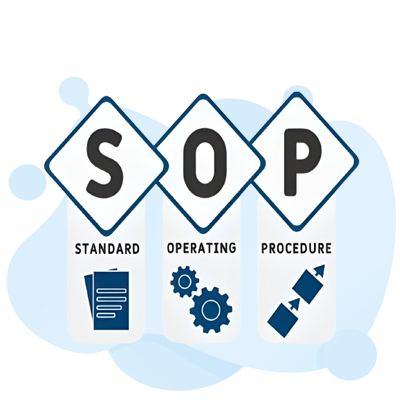SOP Test Guide 2025: Ensure Your Procedures Work

Welcome to our comprehensive guide on SOP 2025 testing! In this section, we will dive deep into the essentials of SOP testing, exploring the importance of evaluating and assessing standard operating procedures (SOPs) to ensure their effectiveness. We will discuss the protocols involved in conducting an effective SOP test and highlight key considerations for seamless procedure implementation. Whether you are new to SOP testing or looking to enhance your current practices, this guide will provide you with valuable insights and best practices to optimize your procedures.
Key Takeaways:
- SOP testing is crucial for evaluating and assessing the effectiveness of your procedures.
- Conducting an effective SOP test involves following specific protocols.
- Seamless implementation of SOPs requires careful consideration of key factors.
- By optimizing your SOPs through testing, you can enhance operational efficiency and mitigate risks.
- Regular evaluation of SOPs ensures continuous improvement and compliance with regulations.
Free SOP Practice Test Online
SOP Test Implementation Process
Implementing a Standard Operating Procedure (SOP) test is a critical step in ensuring the effectiveness and compliance of your procedures. By following the guidelines for creating effective SOPs, ensuring SOP compliance, conducting thorough audits, and measuring SOP performance, you can successfully implement an SOP test that drives operational excellence.
Creating Effective SOPs
When developing SOPs, it is important to establish clear guidelines that outline the desired procedures and outcomes. These guidelines should not only be easy to understand but should also address potential risks and hazards. By adhering to SOP guidelines and incorporating industry best practices, you can create SOPs that are comprehensive, precise, and practical.
Ensuring Compliance with Established Standards
Compliance with established standards is fundamental to the success of an SOP test. SOP compliance ensures that your procedures align with regulatory requirements, safety protocols, and industry guidelines. By regularly reviewing and updating your SOPs to reflect ongoing changes, you can maintain a high level of compliance and operational efficiency.

Conducting Thorough Audits
Auditing your SOPs is an essential part of the implementation process. By conducting SOP audits, you can identify any gaps or deficiencies in your procedures and rectify them promptly. Regular audits also help in evaluating the performance of your SOPs and ensuring that they are effectively meeting their intended objectives.
Measuring SOP Performance
Measuring the performance of your SOPs is crucial for identifying areas that require improvement. By establishing SOP performance metrics and key performance indicators (KPIs), you can track and evaluate the effectiveness of your procedures. Regularly analyzing performance data allows you to make data-driven decisions and optimize your SOPs for better operational outcomes.
In summary, successfully implementing an SOP test requires adherence to SOP guidelines, ensuring SOP compliance, conducting thorough audits, and measuring SOP performance. By following these best practices, you can establish robust procedures that enhance operational efficiency, ensure compliance, and drive continuous improvement.
SOP Test Framework and Documentation
In order to ensure the effectiveness and compliance of your standard operating procedures (SOPs), it is crucial to have a robust framework in place for your SOP test. Implementing best practices for developing and documenting your procedures, as well as conducting thorough compliance tests, will help you achieve optimal results and maintain a high level of operational efficiency.
When it comes to creating a comprehensive SOP framework, there are several key considerations to keep in mind. Firstly, clearly define the purpose and objectives of each SOP to ensure that they align with your organization’s goals. This will help set clear expectations and ensure consistency in the execution of procedures.
Next, establish a standardized format for documenting your SOPs. This includes using descriptive headings, step-by-step instructions, and any necessary diagrams or visuals to enhance clarity. Well-documented procedures make it easier for employees to understand and follow the prescribed processes, leading to improved consistency and accuracy in their work.
Additionally, it is important to regularly review and update your SOP documentation to reflect any changes in regulations or internal policies. This ensures that your procedures remain up-to-date and compliant, minimizing the risk of errors or non-compliance.
Conducting a compliance test is another essential aspect of the SOP test framework. This involves evaluating the level of adherence to established standards and identifying any gaps or areas that require improvement. A comprehensive compliance test should cover both the documentation of SOPs and their actual implementation in practice.
During the compliance test, carefully assess whether your SOPs align with regulatory requirements, industry standards, and internal policies. Pay attention to any discrepancies or inconsistencies that could potentially impact operational efficiency or pose risks to safety and quality.
By following these SOP best practices and employing a robust framework for your SOP test, you can ensure that your procedures are well-documented, compliant, and effective. The careful development, documentation, and compliance testing of SOPs lay the foundation for operational excellence, enabling your organization to meet its objectives and deliver consistent results.

Conclusion
In conclusion, effective SOP test management is crucial for ensuring the smooth running of your business operations. By implementing SOP training programs, you can equip your staff with the necessary knowledge and skills to adhere to standard operating procedures consistently.
Furthermore, maintaining ongoing SOP management practices is vital to keep your procedures up to date and align them with industry standards. Conducting regular procedure examinations and compliance audits allows you to identify any gaps or areas for improvement, ensuring that your SOPs remain effective and compliant.
To enhance the effectiveness of your SOP test, utilize SOP review metrics to track the performance of your procedures and identify areas where optimization is needed. By continuously evaluating and refining your SOPs, you can achieve optimal results and foster a culture of continuous improvement.